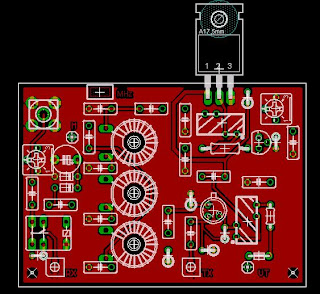PART 4 – RF/PA Board Construction
The concept is to provide enough power, hopefully a couple of Watts, to allow the transceiver to be heard someday on the bands! The RF board is designed only to provide a few (hundred?) milliwatts of output. The design trick here is to provide a reasonable amount of power without quickly draining all the battery power. A 5W transmitter can easily draw several Amps of power. The PA board also has a LPF, to keep us legal as far as spurious emissions, and provide T/R switching. The “extra” cap across the output inductor and careful tuning really helps the efficiency, as this filter matches the output of the amplifier to the antenna as well as suppressing the harmonics. This board is a simple linear FET amp basically copied from one of the many in the literature, but in a form factor we can fit. This is one circuit that probably demands more attention, but works fine for now.
Build test the circuits by injecting a small RF signal and tuning the LPF and amp bias set just to have enough power out to see the RF output using a scope or the power detection circuit connected to a DVM. Moving the LPF coil’s windings closer together one at a time tunes the filter. This takes a little time, but this circuit can deliver over 5W when carefully adjusted. Conversely, if the inductors are off by even one turn the efficiency will be very poor. For the final tuning I connect the LPA to the RF board and the output to a dummy load. To inject the test signal I use a stereo phone connector with a mono jack to disable the internal microphone on the RF board’s test connector (JP11) the tip is the CW signal and the ring disables the microphone output, at it ground to the sleeve when a mono jack is used. Only key the PTT switch for quick measurements being careful not to overheat the LPA’s transistors. The CW level is adjusted from zero and increased until the power stops rising, then back off the injected signal until the output falls. Then final adjustments can be done for max power. I actually use a PC soundcard with a CW program for this signal.



No comments:
Post a Comment